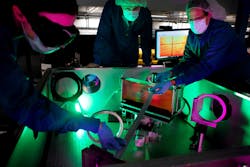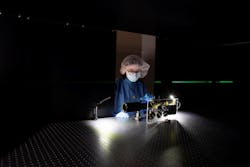University of Michigan fires up ultrafast, ultrapowerful ZEUS laser
The University of Michigan’s Gérard Mourou Center for Ultrafast Optical Science is home to ZEUS, a.k.a. the Zettawatt Equivalent Ultrashort-pulse laser System. It’s the highest-power laser in the U.S., and among the most powerful in the world—making it particularly appealing to researchers exploring extreme plasmas (see video).
“When operating, ZEUS will quite literally be the hottest place in town—for 30 femtoseconds (fs) at a time,” says Louise Willingale, associate director of ZEUS and University of Michigan associate professor of electrical and computer engineering. “It gives us the increased power (3 PW), intensity, and unique configuration so we can perform world-class research into the future.”
ZEUS’s petawatt laser pulse collides with a gigaelectronvolt (GeV) energy electron beam generated by one of its two beamlines, and this geometry provides the equivalent of a zettawatt power laser interaction (1021 W) within the rest frame of the electron beam.
The laser’s name stems from this signature experiment, and Willingale says “quantum electrodynamic effects are expected to alter the behavior of the electron beam experiencing these strong fields.”
Chirped-pulse amplification
There are always challenges putting together a large and complex laser system—all of its elements must be aligned and timed with high accuracy to ensure optimal system performance.
“ZEUS is designed to be as flexible as possible to accommodate many potential experimental configurations,” says Willingale. “It has three different target areas and each has slightly different capabilities for different research projects.”
The underlying concept for creating ZEUS’s high-power pulses is chirped-pulse amplification (CPA), developed by Gérard Mourou and Donna Strickland in 1985, who were eventually honored with the 2018 Nobel Prize in Physics for their work. Without destroying its amplifying material, CPA creates ultrashort, high-intensity pulses.
“An ultrashort seed pulse with energy of 1 nJ is stretched in time about 10000—chirped—to reduce its power,” Willingale says. “The chirped pulse is then safely amplified 11 orders of magnitude to high energy while maintaining its bandwidth, before it’s recompressed to form an ultrashort, high-power pulse. Then, we use the high-power laser pulse for plasma physics experiments by focusing the pulse to a tiny focal volume so that the intensity can exceed 1022 W/cm2, reaching extremely high-field conditions.”Multi-laser beam capability
One of the coolest aspects of ZEUS is its multi-laser beam capability, “which allows us to perform experiments exploring intensity a million times higher than a single laser beam can provide,” says Anatoly Maksimchuk, University of Michigan research scientist in electrical and computer engineering, who leads development of experimental areas.
This is done by “colliding a vacuum multi-GeV electron beam produced by one beam with a tightly focused laser beam with the other arm,” he says. “Such interaction will enable exploring the structure of quantum vacuum and produce matter and antimatter—electron and positron pairs—from nothing.”
A force for scientific exploration
ZEUS can help scientists explore foundational questions about nonlinear quantum electrodynamics in relativistic plasmas, such as their quantum radiation reaction and electron-positron pair production mechanisms.
The laser will enable pump-probe experiments using femtosecond x-rays as a probe of material dynamics on ultrashort timescales, the production of GeV ion beams, the generation of instabilities in in electron-positron jets, the exploration of vacuum polarization effects, relativistic astrophysical shocks, and the production of pions and muons.
“Laser-plasma interaction can generate ultrashort, high-energy particle and photon sources,” says Willingale. “These sources can be used to probe plasma processes or to explore broader applications such as material science, medical imaging, etc.”
ZEUS is now being run as a user facility, and the first user group recently performed the very first experiment—at reduced power. “We’re preparing to launch full operation of the facility to outside users at the end of next year,” says Willingale. “The first call for proposals will be coming out soon and facility access will be awarded through an independent review panel according to scientific merit and feasibility.”
The National Science Foundation is providing the funding for ZEUS.
About the Author
Sally Cole Johnson
Editor in Chief
Sally Cole Johnson, Laser Focus World’s editor in chief, is a science and technology journalist who specializes in physics and semiconductors.


